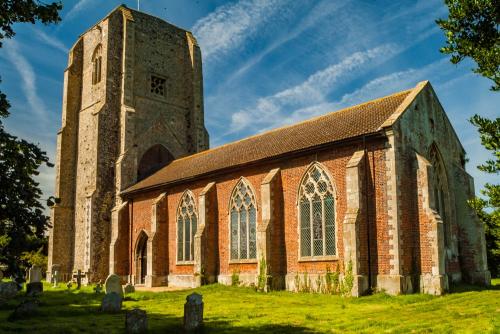
Felmingham is a small village on the B1145 just east of North Walsham, Norfolk. The village appears ion the Domesday Book of 1086, when the land was owned by King William I. The striking parish church, dedicated to St Andrew, is an eye-catching mix of stone, flint, and brick.
History
The first church on this site dates to the 13th century and the list of rectors begins in 1267. That original building was larger than the one we see today, for the church was destroyed by fire in 1742 and had to rebuilt. Only the west tower was spared by the flames, but the remainder of the building dates to the middle of the 18th century and is built largely of red brick.
The nave and chancel were rebuilt using the original south doorway and medieval windows and the church was reopened for worship in 1754.
The tower seems oddly truncated, with angle buttresses rising to the full height of the structure, suggesting that another stage was planned for the top of the tower.
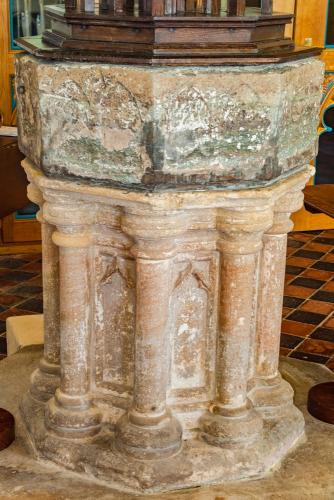
Peasant's Revolt Connections
One resident of Felmingham who must certainly have worshipped at St Andrew's Church was John Litetser (John the Dyer). Litetser was a local leader of the Peasant's Revolt of 1381, when a large group of rural poor marched on Norwich.
The rebels were met by troops under the Bishop of Norwich at the Battle of North Walsham, where they were defeated and the leaders captured. Litetser was hanged, drawn, and quartered, with his body parts put on public display in Great Yarmouth, Norwich, King's Lynn, and at Litetser's own house in Felmingham.
Historical Highlights
The church retains its medieval font, made of Purbeck marble. The bowl dates to the 13th century but it rests on a stem carved in the following century. The font is carved with a pair of Gothic arches on each face. The font cover is beautiful 19th-century work.
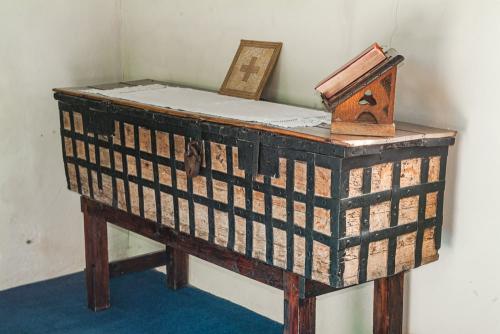
The pulpit, lectern, and pews are also products of the Victorian period. The church guide suggests that the pulpit may be made with fragments of timber salvaged from a medieval rood screen. The pulpit has beautifully carved decoration including figures of a griffin and a woodwose (a wild man of the woods figure found throughout Norfolk and Suffolk).
Fragments of medieval stained glass survive in the north window of the chancel, where you can see a coat of arms to John, 4th Baron Seagrave (d. 1353) and his wife, Margaret. The glass in the east window was brought here from St Philip's Church in Norwich and dates to 1943.
The communion table dates to around 1600. Another early furnishing is a 15th-century parish chest. On the north-east wall is a carved head of Christ brought here from Oberammergau.
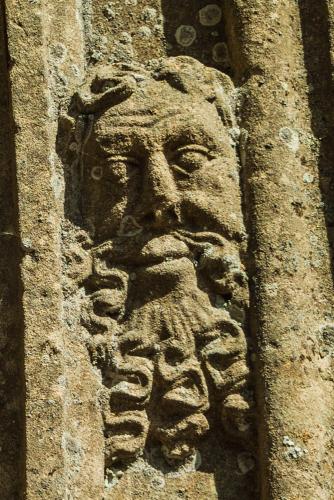
Other survivors of the 1742 fire are painted boards depicting the Ten Commandments, the Lord's Prayer, and the Apostles' Creed. Near the south door are several early memorial brasses.
One of these is a palimpsest (i.e. it has been used on both sides for different memorials). One side commemorates Ursula Wychekynggam, who died in 1530, while the reverse is dedicated to William Elyes (d. 1500). Elyes acted as Wychekynggam's chaplain.
The oldest memorial brass depicts a priest in vestments and dates to 1450, while the reverse side is a memorial to Robert Moone (d. 1591). The largest brass is to William Wyttwood (d. 1628).
As of this writing, Felmingham village does not have an outdoor war memorial, so the Roll of Honour in St Andrew's Church acts as the village's only reminder of service personnel who lost their lives in the two World Wars.
The south door dates to around 1460 and features carvings of heads and shields. Two of the heads decorating the outer hood mould wear crowns, but it is not clear which kings the heads are meant to depict. At the base of the tower's south wall is a fragment of a medieval churchyard cross.
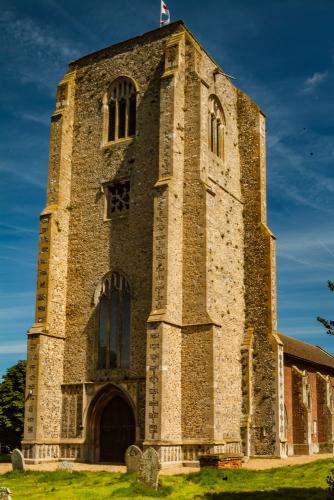
One of the oldest and certainly the most significant grave in the churchyard is to William Talman (d. 1719). Talman served as the Royal Architect at the court of William and Mary. He worked on several prominent stately homes, including Chatsworth House (Derbyshire) and at Hampton Court Palace in London.
There are two war graves in the burial ground, one to Rees Atkins (WWI) and the other to Leonard Hicks (WWII).
Visiting
St Andrew's Church stands on the east side of Church Road, just off the B1145, in the centre of Felmingham. The church is usually open daily to visitors and there is a large car park immediately outside the churchyard.
About Felmingham, St Andrew's Church
Address: Church Road,
Felmingham,
Norfolk,
England, NR28 0LQ
Attraction Type: Historic Church
Location: On Church Road, in the centre of the village. There is a large car park immediately beside the churchyard.
Website: Felmingham, St Andrew's Church
Location
map
OS: TG251292
Photo Credit: David Ross and Britain Express
HERITAGE
 We've 'tagged' this attraction information to help you find related historic attractions and learn more about major time periods mentioned.
We've 'tagged' this attraction information to help you find related historic attractions and learn more about major time periods mentioned.
Find other attractions tagged with:
Domesday Book (Historical Reference) - Peasants Revolt (Historical Reference) -
NEARBY HISTORIC ATTRACTIONS
Heritage Rated from 1- 5 (low to exceptional) on historic interest
Swanton Abbott, St Michael's Church - 2.1 miles (Historic Church) ![]()
Skeyton, All Saints Church - 2.2 miles (Historic Church) ![]()
Burgh-next-Aylsham, St Mary's Church - 3.3 miles (Historic Church) ![]()
Gunton Church - 3.4 miles (Historic Church) ![]()
Oxnead, St Michael's Church - 3.5 miles (Historic Church) ![]()
Worstead, St Mary's Church - 3.7 miles (Historic Church) ![]()
Bure Valley Railway - 3.9 miles (Family Attraction) ![]()
Buxton Mill - 4.1 miles (Historic Building) ![]()
Nearest Holiday Cottages to Felmingham, St Andrew's Church:
More self catering near Felmingham, St Andrew's Church



